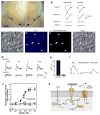Receptor guanylyl cyclases in mammalian olfactory function
- PMID: 19941039
- PMCID: PMC2809823
- DOI: 10.1007/s11010-009-0325-9
Receptor guanylyl cyclases in mammalian olfactory function
Abstract
The contributions of guanylyl cyclases to sensory signaling in the olfactory system have been unclear. Recently, studies of a specialized subpopulation of olfactory sensory neurons (OSNs) located in the main olfactory epithelium have provided important insights into the neuronal function of one receptor guanylyl cyclase, GC-D. Mice expressing reporters such as beta-galactosidase and green fluorescent protein in OSNs that normally express GC-D have allowed investigators to identify these neurons in situ, facilitating anatomical and physiological studies of this sparse neuronal population. The specific perturbation of GC-D function in vivo has helped to resolve the role of this guanylyl cyclase in the transduction of olfactory stimuli. Similar approaches could be useful for the study of the orphan receptor GC-G, which is expressed in another distinct subpopulation of sensory neurons located in the Grueneberg ganglion. In this review, we discuss key findings that have reinvigorated the study of guanylyl cyclase function in the olfactory system.
Figures

Similar articles
-
Olfactory signal transduction in the mouse septal organ.J Neurosci. 2003 Jan 1;23(1):317-24. doi: 10.1523/JNEUROSCI.23-01-00317.2003. J Neurosci. 2003. PMID: 12514230 Free PMC article.
-
A receptor guanylyl cyclase expressed specifically in olfactory sensory neurons.Proc Natl Acad Sci U S A. 1995 Apr 11;92(8):3571-5. doi: 10.1073/pnas.92.8.3571. Proc Natl Acad Sci U S A. 1995. PMID: 7724600 Free PMC article.
-
Functional analysis of the guanylyl cyclase type D signaling system in the olfactory epithelium.Ann N Y Acad Sci. 2009 Jul;1170:173-6. doi: 10.1111/j.1749-6632.2009.04104.x. Ann N Y Acad Sci. 2009. PMID: 19686132 Free PMC article.
-
Guanylyl cyclases as a family of putative odorant receptors.Annu Rev Neurosci. 2000;23:417-39. doi: 10.1146/annurev.neuro.23.1.417. Annu Rev Neurosci. 2000. PMID: 10845070 Review.
-
Function and dysfunction of mammalian membrane guanylyl cyclase receptors: lessons from genetic mouse models and implications for human diseases.Handb Exp Pharmacol. 2009;(191):47-69. doi: 10.1007/978-3-540-68964-5_4. Handb Exp Pharmacol. 2009. PMID: 19089325 Review.
Cited by
-
Mutations in Tyr808 reveal a potential auto-inhibitory mechanism of guanylate cyclase-B regulation.Biosci Rep. 2013 May 24;33(3):e00039. doi: 10.1042/BSR20130025. Biosci Rep. 2013. PMID: 23586811 Free PMC article.
-
Atrial natriuretic factor receptor guanylate cyclase, ANF-RGC, transduces two independent signals, ANF and Ca(2+).Front Mol Neurosci. 2014 Mar 17;7:17. doi: 10.3389/fnmol.2014.00017. eCollection 2014. Front Mol Neurosci. 2014. PMID: 24672425 Free PMC article. Review.
-
Olfactory signaling via trace amine-associated receptors.Cell Tissue Res. 2021 Jan;383(1):395-407. doi: 10.1007/s00441-020-03331-5. Epub 2020 Nov 25. Cell Tissue Res. 2021. PMID: 33237477 Free PMC article. Review.
-
An Evolutionary Microcircuit Approach to the Neural Basis of High Dimensional Sensory Processing in Olfaction.Front Cell Neurosci. 2021 Apr 30;15:658480. doi: 10.3389/fncel.2021.658480. eCollection 2021. Front Cell Neurosci. 2021. PMID: 33994949 Free PMC article.
-
High density and ligand affinity confer ultrasensitive signal detection by a guanylyl cyclase chemoreceptor.J Cell Biol. 2014 Aug 18;206(4):541-57. doi: 10.1083/jcb.201402027. J Cell Biol. 2014. PMID: 25135936 Free PMC article.
References
Publication types
MeSH terms
Substances
Grants and funding
LinkOut - more resources
Full Text Sources
Other Literature Sources
Miscellaneous

